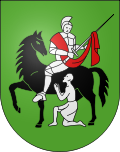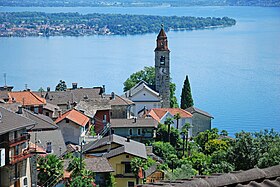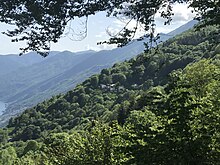Ronco sopra Ascona
| Ronco sopra Ascona | |
|---|---|
| State : |
|
| Canton : |
|
| District : | Locarno district |
| Circle : | Circle Isole |
| BFS no. : | 5125 |
| Postal code : | 6622 |
| Coordinates : | 699 392 / 111094 |
| Height : | 353 m above sea level M. |
| Height range : | 193-1378 m above sea level M. |
| Area : | 5.00 km² |
| Residents: | 587 (December 31, 2018) |
| Population density : | 117 inhabitants per km² |
| Website: | www.ronco-s-ascona.ch |
|
Ronco sopra Ascona |
|
| Location of the municipality | |
Ronco sopra Ascona , in the alpine Lombard local dialect Ronch [ Ronk ], is a municipality in the Swiss canton of Ticino ( District Locarno , county Isole ).
geography
The municipality of Ronco lies on the one hand between Ascona and Brissago and on the other hand between the Langensee (193 m above sea level) and the Corona di Pinz (or Corona dei Pinci; 1294 m above sea level), but also extends a little over the Ridge out into the Centovalli. The highest point of the community is 1374 m above sea level. M. the mountain ridge near the Alpe di Naccio, which already belongs to Brissago.
The village center is located on a rock terrace around 160 meters above the lake. The municipality also includes the hillside districts of Livurcio, Croasca, Corafora, Capella Gruppaldo and Fontana Martina, as well as Porto Ronco, which is located on the lake, and which are now partly structurally fused with the historic Nucleo (village center).
In the Monti di Ronco, at an altitude of 650 to 1150 meters, are the Alpine settlements of Puran, Calzo, Cassina and Purèra, and just above the Monti di Schiavardo. Today these can be reached not only by footpaths but also by a winding road from Cappella Gruppaldo and offer a panoramic view of the Langensee and the Ticino mountains.
history
Place name
The name Ronco comes from the Middle Latin runchum 'freshly cleared land that is to be reclaimed; Weinberg ', which in turn goes back to the Latin runcāre ' dig, clear, make arable '.
development
Ronco was first mentioned in 1264 as Roncho de Schona 'Ronco / Weinberg von Ascona'. In the late Middle Ages, it formed a neighborhood with Ascona with its own statutes from 1369. It became an independent parish in 1626, and in 1641 the village parish separated from the neighborhood. In the early modern period, the residents of Ronco were involved in the monopoly of luggage loading at the customs of Florence and Livorno , which is still evidenced by an inscription on the Gruppaldo chapel.
Structurally, the different epochs are still clearly legible. In addition to medieval buildings and elements, reshaped or newly built houses, room and facade paintings, granite entrance portals and graceful balconies with wrought iron bars in the 17th and 18th centuries bear witness to a relative wealth that can be associated with the emigration of significant parts of the population at the time .
Today Ronco is a popular holiday village as well as a place of residence and accordingly has a large number of second homes. In 2014 this share was 69.8% according to building and housing statistics. According to Swiss legislation, no second homes may therefore be built.
Artist village
The original winegrowing and cattle breeding village developed into an artists' village in the early 20th century. For a long time, the painter, graphic artist and writer Richard Seewald (1889–1976), the painters Jan Schutter (1890–1956), Manfred Henninger (1894–1986), Erwin Schönmann (1906–1999) , who joined forces in the Circolo Verbano , worked in Ronco. , Willy Hug (1910–1996), Karl Gerber (1912–1974) and Rös Schutter-Peter (1920–2001), the painter Paul W. Loosli (1896–1962) and the textile artist Rolf Lenne (1904–1986).
The hamlet of Fontana Martina , which belongs to Ronco, was temporarily a small country and artist cooperative after the then disintegrated group of houses was bought in 1923 by the Bern printer Fritz Jordi (1885–1938) and restored together with the versatile artist Heinrich Vogeler and the graphic artist Clément Moreau was; and Paul Klee (1879-1940) was a frequent visitor. The ideal goal was to set up an artistic center like the one presented by Barkenhoff in Worpswede , and from October 1931 to November 1932 the group published its own bi-monthly magazine called "Fontana Martina".
The writer Erich Maria Remarque (1898–1970) and his wife, the actress Paulette Goddard (1910–1990), also settled in Ronco , as did the writer Eveline Hasler (* 1933). The citrus grower Edwin Frey (1911-2000) named one of his varieties Corafora, named after a locality in Ronco.
In the early 20th century, the slope between Ascona and Ronco was populated by people who could be assigned to the immediate and wider area of the dropout colony of Monte Verità . The novel Benedikta by Gabriele Reuter (1923) also plays in Ronco , in which "some kitschy, enthusiastic naturals" appear.
population
Residents
| Population development | ||||||||||||||
|---|---|---|---|---|---|---|---|---|---|---|---|---|---|---|
| year | 18th century | 1850 | 1900 | 1950 | 1980 | 2000 | 2010 | 2018 | ||||||
| Residents | 450-500 | 378 | 257 | 540 | 745 | 659 | 678 | 587 | ||||||
Up until the 18th century there were around 100 fuochi 'fires, hearths', meaning families, in Ronco , which corresponds to a population of 450 to 500 inhabitants. In 1869 there were 110 families in the community; subsequently the population decreased so that around 1900 there were only 257 people. Ronco experienced a new high with 745 inhabitants in 1980, since then it has fallen to below 600 inhabitants (as of 2018). The proportion of foreigners in 2006 was 167 people.
Language and dialect
In 2000, 405 residents were Italian, 222 German, 8 French and 24 other mother tongues. In the same year, 12% of the population spoke exclusively the local Alpine Lombard dialect and 28% both dialect and Italian. The proportion of dialect speakers is thus significantly lower than the Ticino average (14% only dialect, 40% dialect and Italian).
traffic
Ronco is accessible to the public with two bus routes operated by Ferrovie autolinee regionali ticinesi (FART) . Bus number 314 goes from Locarno train station to Losone, Arcegno and to the center of Ronco sopra Ascona and back. The number 316 bus also goes from Locarno train station to Ascona, then through the Ascona tunnel along the Langensee to Porto Ronco and Brissago and back.
The ship landing stage at Porto Ronco is served from April to October by the Società Navigazione del Lago di Lugano , which replaced the Italian Navigazione Laghi in 2018. The ships sail northeast towards Ascona and Locarno, southwest towards Brissago, Cannobio and Verbania and over to the Brissago Islands.
economy
In 2000, 7 people worked in the primary, 55 in the secondary and 167 in the tertiary sector. Three fifths of the workforce were commuters. Three families were still active in agriculture in 2007 (nine in 1990). There is a goat farm in Calz above the village.
Attractions
The densely built-up center of Ronco sopra Ascona is a prime example of a compact village and contains both medieval houses and elements of rural design as well as numerous buildings from the 16th to 18th centuries. The traditional house is a tower house, consisting of a (former) stable or cellar on the ground floor, kitchen / living room on the first floor, bedroom on the second floor and an attic above. Today, many of these tower houses have merged with the neighboring buildings to form larger units that are now horizontally instead of vertically divided inside. Typical of Ronco are the numerous underpasses, called barchétt in the dialect , that is, places where a lane leads under part of a house.
The parish church of San Martino is a late medieval building that was rebuilt in the 17th and early 19th centuries; the tower was completed in 1563, the crown is from 1860. Inside, the church has late Gothic frescoes by Antonio da Tradate as well as stucco and paintings from the 17th century; the altarpiece in the late baroque altar, which shows Saint Martin , is by Antonio Ciseri . - The nearby Madonna delle Grazie chapel is a Baroque building from 1712, the frescoes in the dome are from around 1730.
Opposite the parish church is the Casa Ciseri, a building from the 17th century that was rebuilt around 1830. On the ground floor there are halls with romantic and classical decorative paintings; these rooms are open to the public.
In Porto Ronco there are two witnesses of classical modernism on the lakeshore , namely the Casa Hahn or Fontanelle and the Casa Tutsch, both built by Carl Weidemeyer in 1928/1931 .
Personalities
Ronco sopra Ascona is the birthplace of the painter Antonio Ciseri (1821–1891), who made a career in Florence. Mainly in the first half of the 20th century, numerous people active in the arts and culture settled in the community, see the section Artists' Village . Max Emden (1874–1940), a German wholesale merchant and art collector who owned the Brissago Islands from 1927, was naturalized in Ronco sopra Ascona in 1934.
literature
- Cornelia Ammann: Ronco com'era - as it was. CM Schwarz, Ronco s / Ascona 2011.
- Rodolfo Huber: Ronco sopra Ascona. In: Historical Lexicon of Switzerland . April 23, 2010 , accessed December 31, 2019 . Volume 10, p. 437.
- Agostino Robertini, Silvano Toppi, Gian Piero Pedrazzi: Ronco sopra Ascona. In: Il Comune. Edizioni Giornale del popolo, Lugano 1974, pp. 313-326.
- Cornelia Schwarz-Ammann, in collaboration with Stefano Vassere, Ermanno Barioni and Tarcisio Pellanda: Repertorio toponomastico ticinese. I nomi di luogo dei comune del Cantone Ticino: Ronco sopra Ascona. Edited by the State Archives of the Canton of Ticino, Bellinzona 2007 (bilingual Italian and German).
- Niklaus Starck : Circolo Verbano. The painters of Ronco sopra Ascona. Porzio Verlag, Ascona / Breitenbach 2015.
- Celestino Trezzini : Ronco at Ascona. In: Historisch-Biographisches Lexikon der Schweiz , Volume 5: Retornaz - Saint Didier. Attinger, Neuenburg 1929, p. 694 ( digitized version ).
- Art guide
- Mario De Rossa: BDL (Benefattori di Livorno). Le loro testimonianze nelle Terre di Pedemonte, nelle Centovalli ea Ronco s / Ascona. In: Arte & Storia: Svizzeri a Pisa e Livorno. Edizioni Ticino Management, Volume 14, Number 62, Lugano 2014, pp. 262–281.
- Virgilio Gilardoni : I monumenti d'arte e di storia del Canton Ticino. Volume II: L'alto Verbano I. Il circolo delle Isole (Ascona, Ronco, Losone e Brissago) (= The art monuments of Switzerland. Volume 68). Edited by the Society for Swiss Art History SKG. Bern 1979, ISBN 3-7643-1117-7 , pp. 22, 23, 41, 48, 77, 81, 85, 94, 95, 112, 128, 218, 245, 273, 278, 363, 415, 419, 423.
- Art guide through Switzerland. Completely re-edit Output. Edited by the Society for Swiss Art History. Volume 2. GSK, Bern 2005, ISBN 3-906131-96-3 , p. 621 f.
- Simona Martinoli u. a .: Ronco sopra Ascona. In: Guida d'arte della Svizzera italiana. Edizioni Casagrande, Bellinzona 2007.
Web links
- Ronco sopra Ascona on the ETHorama platform
- Official website of the municipality of Ronco sopra Ascona
- Data from the municipality of Ronco sopra Ascona
- Office for Statistics of the Canton of Ticino: Ronco sopra Ascona
- Ronco sopra Ascona: inventory of cultural assets of the Canton of Ticino
- Ronco sopra Ascona on de.lagomaggiore.net, accessed November 25, 2015
- Ronco sopra Ascona on elexikon.ch
- Ronco Sopra Ascona on ticinarte.ch
photos
View of the Brissago Islands from Ronco
Individual evidence
- ↑ Permanent and non-permanent resident population by year, canton, district, municipality, population type and gender (permanent resident population). In: bfs. admin.ch . Federal Statistical Office (FSO), August 31, 2019, accessed on December 22, 2019 .
- ↑ a b c d e f g h Repertorio toponomastico ticinese. I nomi di luogo dei comune del Cantone Ticino: Ronco sopra Ascona. Edited by the State Archives of the Canton of Ticino, Bellinzona 2007, pp. 167–170.
- ↑ a b Lexicon of Swiss municipality names . Edited by the Center de Dialectologie at the University of Neuchâtel under the direction of Andres Kristol. Frauenfeld / Lausanne 2005, p. 755.
- ↑ Fontana Martina on ethorama.library.ethz.ch/de/node
- ↑ Community list with share of second homes. Building and dwelling statistics, special evaluation GWS, BFS 2012, valid on January 1st, 2014. CATEF March 17th, 2015
- ^ Cf. Niklaus Starck : Circolo Verbano. The painters of Ronco sopra Ascona. porzio.ch, [Ascona 2015].
- ↑ See Repertorio toponomastico ticinese. I nomi di luogo dei comune del Cantone Ticino: Ronco sopra Ascona. Edited by the State Archives of the Canton of Ticino, Bellinzona 2007, p. 197.
- ^ Paul Klee on ticinarte.ch.
- ^ New edition: Fritz Jordi and Heinrich Vogeler (eds.): Fontana Martina. Half-monthly publication. Complete facsimile print of the half-monthly publication published by Fritz Jordi and Heinrich Vogeler in 1931/32 in Ronco s./Ascona. With an appendix ed. by Dietger Pforte. Anabas-Verlag, Giessen 1976 and 1981.
- ^ Robert Landmann: Ascona - Monte Verità. In search of paradise. Huber, Frauenfeld 2000, p. 75.
- ^ Rodolfo Huber: Ronco sopra Ascona. In: Historical Lexicon of Switzerland . November 15, 2010 .
- ↑ FART bus routes on centovalli.ch (accessed on March 15, 2017).
- ↑ See Lessico dialettale della Svizzera italiana . Volume 1, p. 223.
- ↑ Art guide through Switzerland. Edited by the Society for Swiss Art History. Volume 2. Bern 2005, p. 621 f.
- ↑ a b Art guide through Switzerland. Edited by the Society for Swiss Art History. Volume 2. Bern 2005, p. 622.









